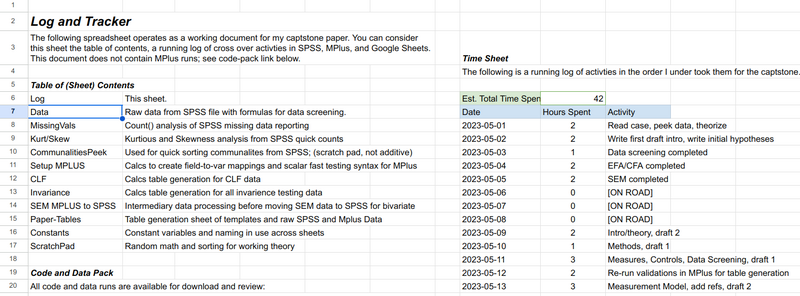I stared at the ceiling in the hotel room as the air left my lungs in a deep sigh of relief. The semester of classes and seminars had ended, nearly completing my second year as a doctoral student. The key word in that sentence would be nearly, as I lifted my head to peek at my open laptop, it’s chime alerting to a screen blurred with color with a single email notification.
The quantitative capstone had arrived.
As part of the doctoral program before you can continue into your third year, you must complete said capstone at the end of your second year. The capstone is a specific type of comprehensive exam that is more inline with analyzing data and writing a research paper that one might submit to a journal. It is not an alternative per-se to traditional oral and written comps—in Spring 2024 I will have to complete those traditional exams to move from PhD Student to PhD Candidate all things equal. Said paper becomes a treatise on the application of many hours of learning and rigor put in across the second year.
This is also not a turn-around-in-eight-hours comp. You have time, a deadline of almost a month to author and turn in to your reviewers said paper. Time however is not necessarily on your side; in the case of our comp, the range estimate to complete and pass is somewhere between 20 and 120 hours. Some noted it could take close to 200 hours. Some professors and former PhDs recommended taking two weeks off of work; others noted that you should isolate and just focus away from distractions.
Further, you could not ask for assistance if you hit a roadblock (questions about the exam deliverables or data file problems notwithstanding). No talking to your cohort. No asking for a double-check of your data runs. And keep it tight: 30 pages max with 20 pages of appendix and references, hit the marks.
Ready. Set. Deep breath.
***
The last half year has been all quant all the time. My qualitative paper had been successfully accepted by the program (which was fantastic), but was still going through edits as I prepared to submit to a few conferences at the urging of my supervisor and advisors—which I am over the moon about. However, that soon took a back seat as the sheer volume of quant to learn to prepare for the capstone and my second and third studies was no laughing matter.
Rigor doesn’t even begin to explain the depths to which we went. This does not preclude the upcoming third year which goes deeper still. “It only gets more difficult,” one former PhD noted, but was quick to point out “put in the time, listen, read, and above all else don’t fall behind.”
It would be insincere to say that the ease of this phase of the doctoral program—quant, second study design, new collaborators, some teaching on the side, my Doctoral-to-PhD application—is simple. Frankly, it’s not. It is hard. Damn hard, even with all the fantastic support offered by the program. But support doesn’t beget that they’re going to cake walk you through: you put in the time, otherwise you don’t keep moving forward.
After a particularly bad day of flooding and attempting to write, I took an honest look at the deliverables ahead and felt the butterflies that so often temper my intuition: double down and engineer the shit out of this. I came up with my own approaches to running analysis in a very Justin-is-still-a-software-engineer-at-heart sort of way, summarized early in winter as I started building tools. I started writing a survival guide, an in-and-out of procedures and processes, seminal papers, and references. Religious texts emerged as daily reads: Hairs’ Multivariate Data Analysis, Hayes’ mediation, moderation, and conditional process analysis, Brown’ Confirmatory factor analysis for applied research. When in doubt, I called colleagues and hashed out approaches, following the citations like breadcrumbs
Between the tedious work and runs of data analysis, we often laughed. We laughed at the archaic nature of using MPlus, a powerful tool hamstrung by an interface from 1980’s computing. We laughed about reading JN plots backwards and the power of tiny interactions. We laughed at the exhaustion between long flights and even longer video calls.
In all, the effort I put into the grueling winter months paid off. I was able to analyze and write my paper in a mere 40 hours, and spent just two hours answering questions as part of a minor revision round before the paper was approved with exemplary marks. I cannot say for certain what my other collegues appraoches were or the time they spent, but during upcoming reviews and recaps at the end of July, I look forward to hearing their stories.
***
As a final note, I am often asked about the nature of work one undertakes as part of the program. I would love to sugar coat this for people and say “it’s simple, just follow the steps” but the reality is it’s not. Case’s program requires a significant amount of time (it is a full-time program), and no one lets you off the hook; the rigor is there for a reason, which becomes very clear as you start sharing research and talking to others outside your immediate sphere at the university. The expectations are high and some people find that it either does not fit their life given time constraints or obiligations. If you do consider the program (which I love!) understand it will consume a great deal of your time/life/mind.


